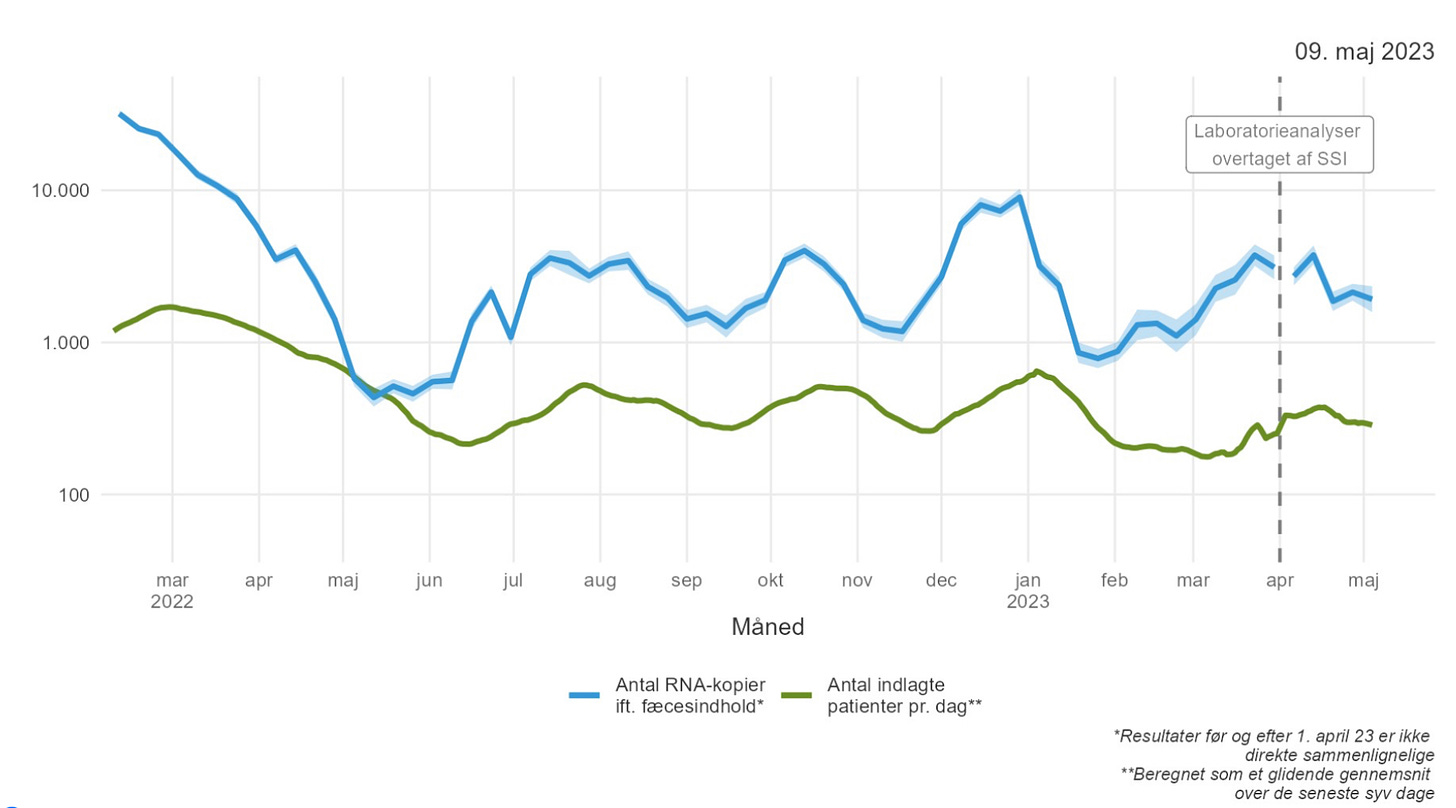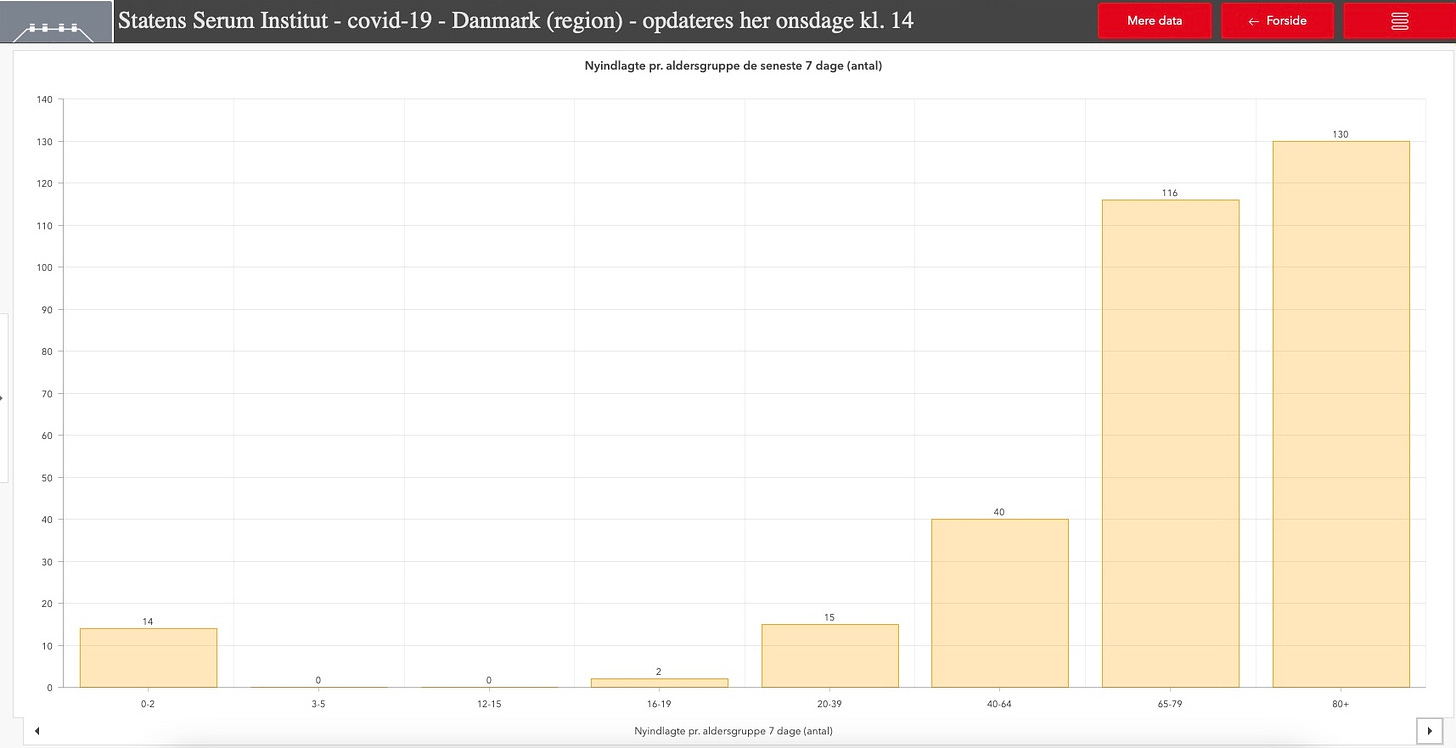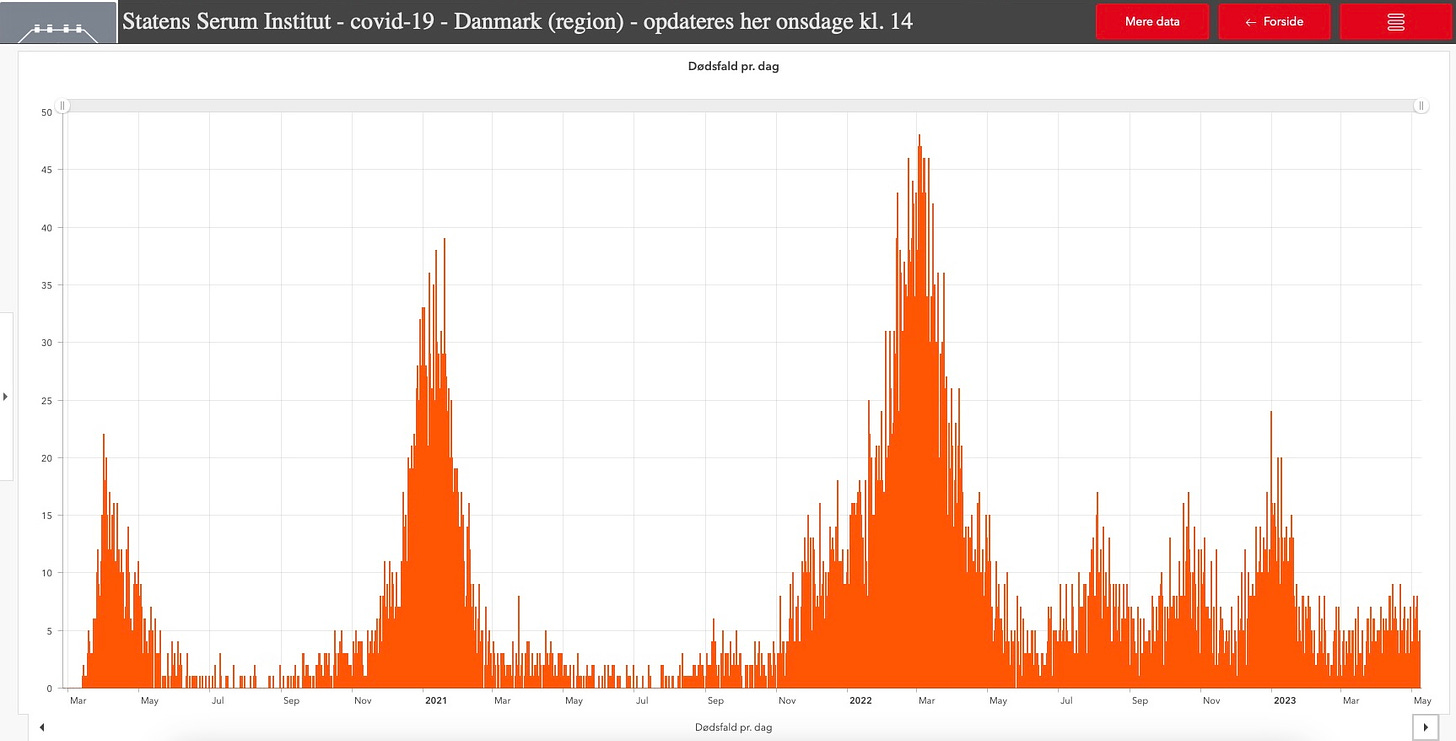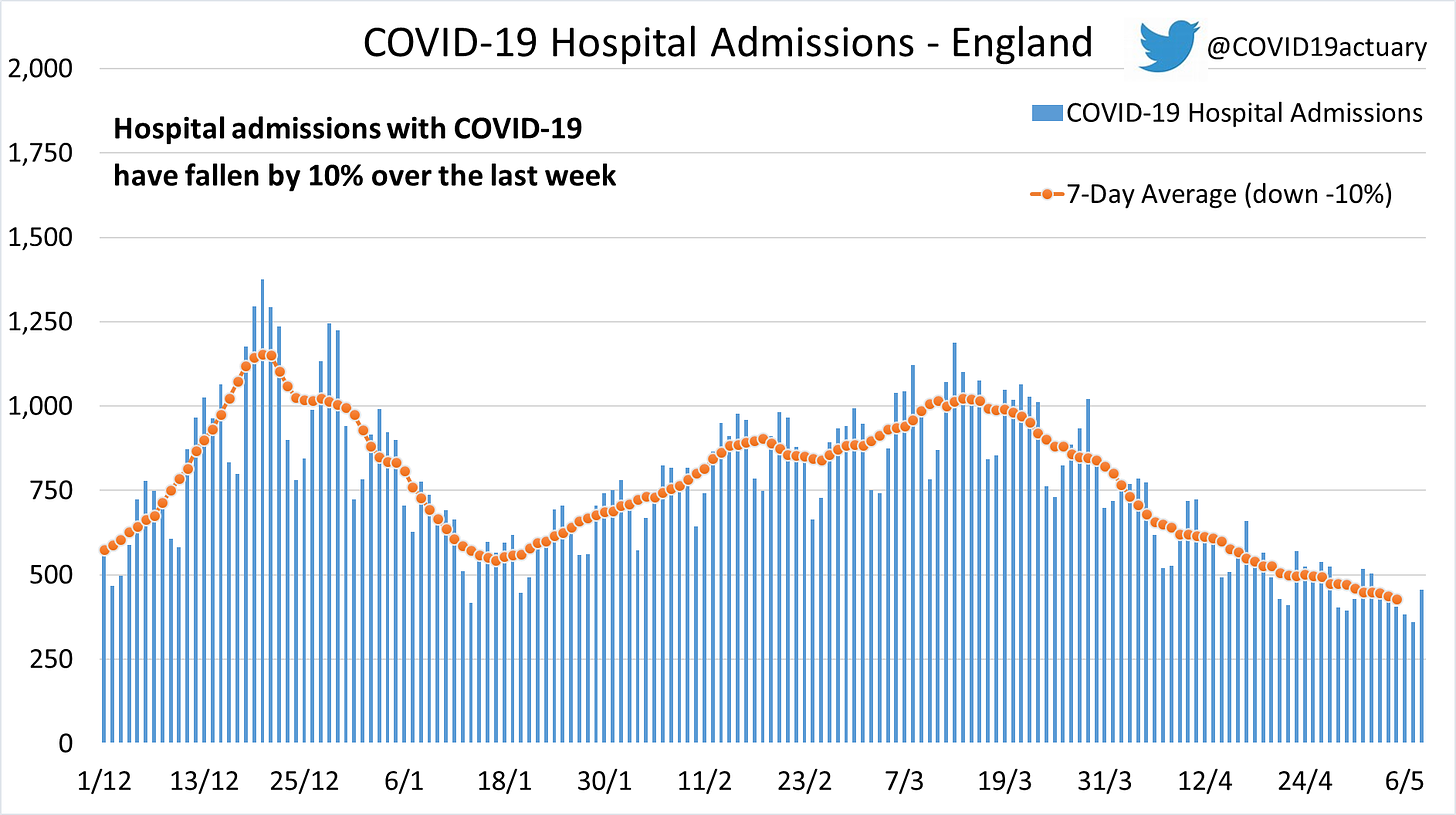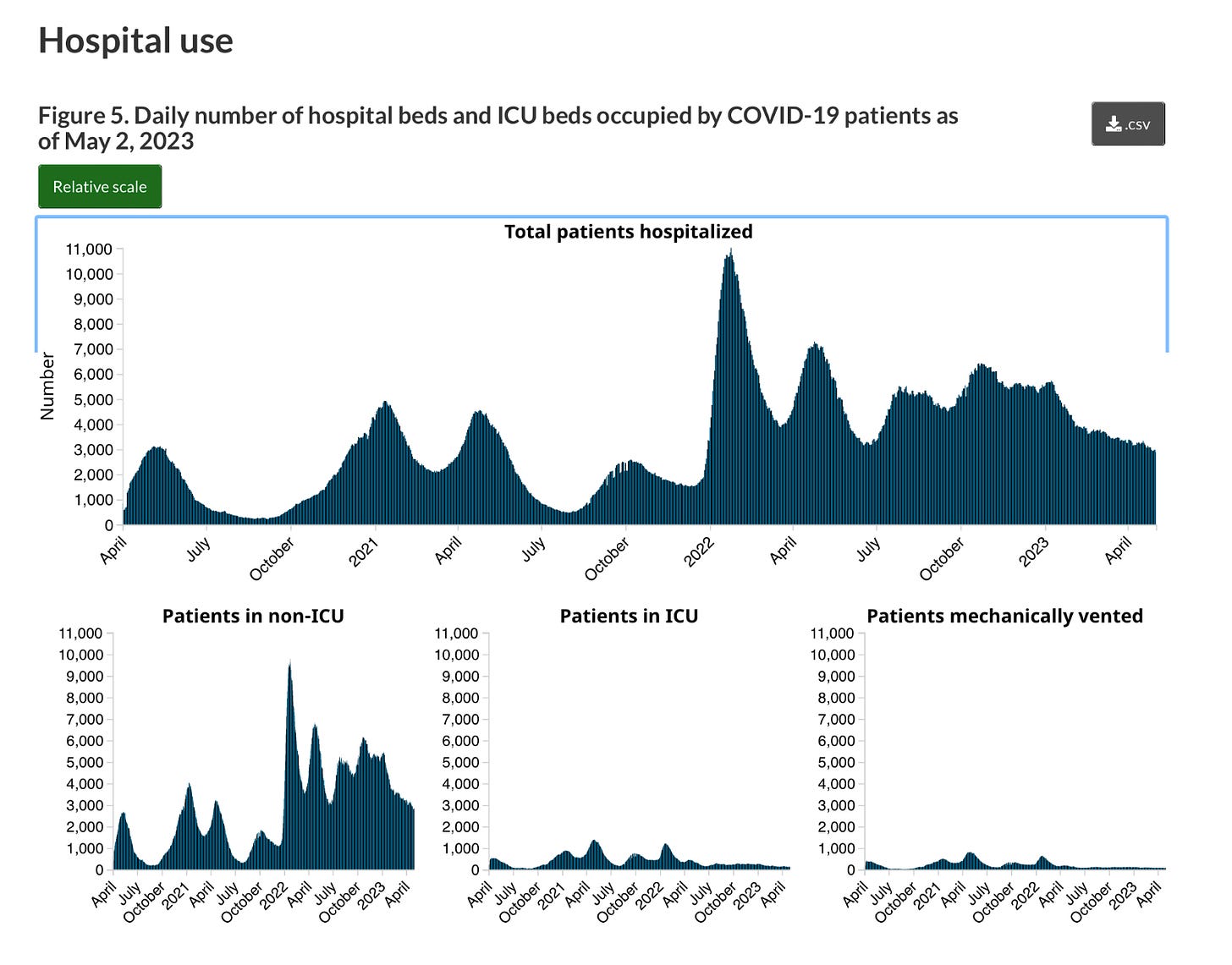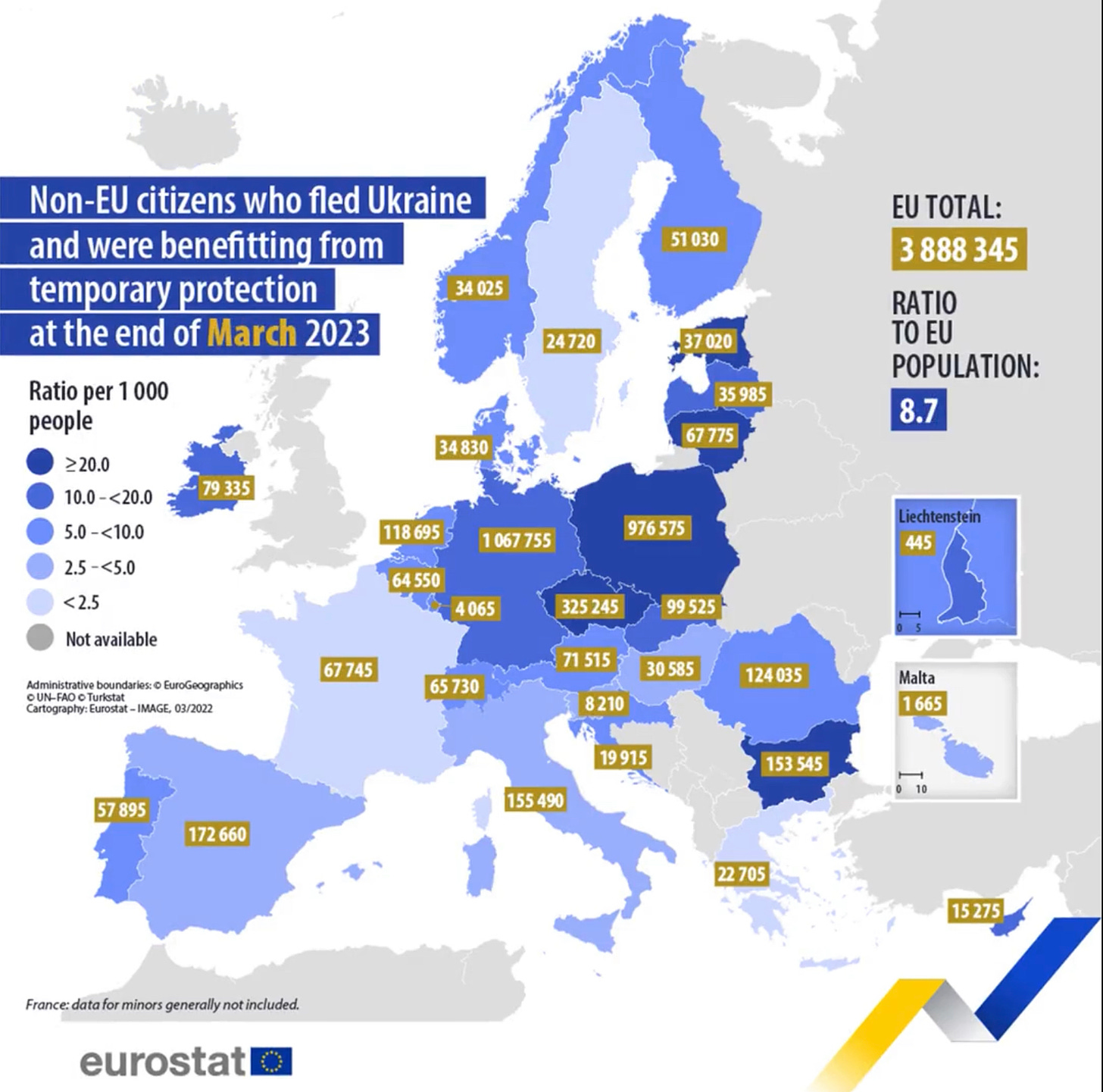The Evening Report - May 11
Denmark’s healthcare system recovering. Spring infection wave in Finland.
🦠Pandemic🦠
🇩🇰
The Danish healthcare system is working hard to tackle a massive backlog of procedures and operations accrued due to the COVID pandemic and last year’s nurses’ strike. In February, the government reached a deal with the Danish Regions to unleash an emergency plan to address the backlog and wrestle waiting times down. In the first progress report from the Danish Regions, it shows that significant progress is being made but a lot more work still needs to be done. It says the number of operations is “significantly over” the agreed benchmark. But so far waiting times have yet to be reduced. The latest figures show a 46-day minimum wait for treatment while people are waiting 65 days for surgeries. This remains a significant increase from wait times in 2020. The Regions attribute this in part to a still heavy load on hospitals and especially in emergency rooms that continues to hold things up.
Health Minister Sophie Løhde spoke to Ritzau to say while progress has been made this is just a start.
“But we are still far from the goal, and unfortunately we have to expect that the waiting times for operations will be longer than before the COVID pandemic for a while before we see the curve break. It is therefore absolutely crucial that we maintain a high level of activity for the rest of the year and in 2024 because we must continue to reduce the excessively long waiting times for patients.”
The emergency plan has the goal of bringing wait lists back to the threshold required by law in Denmark by 2024.
-
Stable, that is how the Danish Statens Serum Institute is describing the pandemic situation or what it can see of it with its lack of testing. Last week, there were approximately 4,500 PCR tests administered in Denmark. The SSI says infection numbers, positivity percentage, hospitalizations, and COVId wastewater surveillance have all been stable in recent weeks.
The institute says recombinant variant strains, especially XBB.1.5 and XBB.1.9.1, remain “especially dominant.” But it cautions with low testing activity and with about 100 positive tests being sequenced the variant picture is extremely fuzzy at best. The SSI adds that while XBB.1.16 seems to be taking over in a number of other countries “few cases have been seen in Denmark.”
-
The seven-day positivity percentage is 13.2%, a slight week-to-week increase.
-
COVID hospitalizations (290) have dropped (-13) while the number of severely infected people in an ICU (10) is unchanged and of those, the number on a ventilator (4) has edged upward (+2).
The number of infection-related admissions to a psychiatric facility (23) has eased somewhat (-6).
Seniors over 65 continue to take the brunt of COVID hospitalizations accounting for 78% of all infection-related admissions in the last week.
-
In the last week Denmark reported 50 more COVID deaths, a number that remains far too high.
🇸🇪
In Sweden, COVID hospitalizations 448 have fallen (-66) while intensive care numbers (10) have increased (+5).
-
The Swedish Public Health Agency is making changes to its pandemic preparedness plans as it seeks to utilize the lessons learned during the COVID pandemic. One fundamental change is to broaden the focus of pandemic preparations. Up until now, the health authority had based response plans specifically for a pandemic caused by influenza. It is now opening the scope to include other infectious diseases.
Based on the last three years of dealing with the COVID pandemic there is also now more of an emphasis on collaboration in pandemic preparation planning. The other area of importance is communication. The agency says there needs to be more of an effort to reach everyone across society when a pandemic strikes “and especially those not reached by broad communication efforts.”
Preparedness and Crisis Management Unit Head Anette Richardson:
“Good preparedness for a pandemic strengthens society's resilience in order to save lives and maintain long-term good health in the entire population. We are now in a situation where authorities, regions and municipalities can develop their preparedness based on the lessons we have learned from handling COVID so far.”
-
Since Brexit, Sweden has ordered more British citizens to leave the country than any other EU member nation. But the European Union statistics agency, EuroStat, says the blame goes to the COVID pandemic and not Britain’s decision to abandon the European Union. EuroStats says of the 1,100 Brits ordered to leave Sweden in the last two years, more than 90% were due to orders related to the COVID entry restrictions that were in place at the time.
🇫🇮
Finland has recorded 1,643 new infections while losing another 119 lives to the pandemic over the last week.
-
Finland is seeing a spring COVID wave but, as far as they can tell, numbers are now here near what they were a year ago.
The Finnish Institute for Health says COVID hospitalizations and ICU admissions have increased since mid-March but again not anywhere close to the number they saw last spring. The institute adds that “the growth has slowed down.”
As is the case elsewhere, it is seniors over 65 in Finland who are being hospitalized in the highest numbers.
COVID wastewater surveillance also indicates increasing virus activity across Finland in recent weeks.
The agency says the XBB.1.5 variant is dominant in Finland making up 45% of what positive tests are still being sequenced.
Chief Physician Tuula Hannila-Handelberg:
“There is currently a spring infection wave in Finland, and the institute is monitoring the situation. As summer approaches, infection numbers usually decrease, but it is important to identify those patients who are most at risk of a severe infection.”
Along with an overall lack of testing, the institute adds that a number of people get infected but remain asymptomatic further masking the true number of infections.
The institute continues to urge people who have symptoms and who are sick to stay home.
“You should take the recommended number of COVID vaccine doses and stay home when you are sick. You should assess your own risk and that of others. If you are planning a visit to someone who is elderly or people in a high-risk group, it is best to ask them before you visit.”
🇳🇴
The pandemic situation in Norway is “relatively stable” according to the latest bi-weekly update from the Norwegian Institute of Public Health. The agency says COVID wastewater surveillance has shown decreasing virus activity in the last four weeks.
Infection-related hospitalizations are also falling with 152 admissions in the last 14 days. There have been just two intensive care admissions in the same number of weeks.
Norway has suffered another 52 coronavirus deaths in the last two weeks. But the NIPH notes excess mortality rates are within normal levels.
On the variant front, XBB.1.5 remains dominant in Norway but the institute notes the XBB.1.9 strain is seeing increasing numbers of cases.
In Norway, seniors over 75 can get another booster dose if it has been more than six months since their last one. The NIPH says in the age group 61% have had a 2nd booster dose and 24% have so far had a 3rd.
-
The number of influenza infections in Norway has now fallen below the outbreak threshold. But the Norwegian Institute of Public Health cautions the seasonal flu is still circulating. The number of flu-related hospitalizations increased week to week from 23 to 34. It says there hasn’t been a single flu-related intensive care admissions in the last week.
The number of people in Norway who got a flu shot this year remains uninspiring. 64% of seniors over 65 had a flu shot. Among those in high-risk groups 18 to 64 years old the vaccination rate was just 36%. For children under 17, it was a mere 7.9%.
🇩🇰 🇸🇪 🇩🇪
The Swedish and Danish Ministries of Finance have been handed a large headache. The European Court of Justice has ruled that Sweden and Denmark’s pandemic-related bailout of troubled Scandinavian air carrier SAS was invalid. The judgement is now getting a thorough going over Sweden and Denmark’s respective Justice Ministries as they try to decide the next steps. In a statement, SAS says it too is examining the decision.
The court also made a similar ruling annulling the pandemic bail out of Lufthansa by the German government.
🇬🇧
Pandemic-related hospitalizations in the United Kingdom continue to ease. According to the COVID Actuaries Response Group hospital admissions were down 10% week to week. Regionally, hospitalizations rose in the East but fell in every other English region.
The COVID reinfection rate, or R0, remained “fairly stable” at 0.94. Anything over 1 signals degrees of an increasing epidemic.
🇨🇦
In its latest weekly report, the Public Health Agency of Canada has registered 4,992 new COVID infections and another 113 coronavirus deaths.
The weekly positivity percentage is 10%, a slight week-to-week decrease.
-
The national health agency says of all the circulating coronavirus variants in Canada only the recombinant strains XBB.1.9, XBB.1.16, and XBB.2.3 are seeing increased growth. All other variants are either treading water or are in decline.
-
Most COVID hospitalization numbers declined again across Canada. In the week ending May 2, the total number of beds in use by a pandemic patient dropped by 191 to 2,881. Infection-related general admissions fell from 2,944 to 2,753 from week to week. The number of severely infected people in an ICU was static remaining at 128. While the number of people on a ventilator crept downward by one to 69.
-
A study from Vancouver, Canada, did a deep dive into how long-COVID develops and its results are worrying. In order to increase our understanding of long-COVID and how it works, researchers poured over every bit of scientific evidence they could find.
For instance, the longest instance of long-COVID recorded to date was a woman in the UK who continued to test positive for 505 days between recovering from infection and her death. But why? Examining autopsy results across multiple countries there was evidence that the virus hangs on inside the body in a shocking number of locations long after recovery. For example, autopsies in 44 people infected with COVID found the virus in 84 different parts of the human anatomy up to 230 days after infection.
In another case, researchers in Italy noted 27 consecutive patients who recovered from infection but actually saw their condition get progressively worse despite repeatedly testing negative. Autopsies in those cases showed coronavirus continuing to shed in their lung tissue for up to 300 days after recovering from severe infection.
Autopsies aside, researchers in Singapore found virus residue still active in the appendix, skin, and breast tissue of two patients 163 days and 426 days respectively after being infected. Similarly, in Spain, researchers found coronavirus still present in intestinal specimens of people six months after recovery. In Austria and the USA, similar findings were made in stool samples of COVID patients seven months after testing positive “which might imply that the gut of individuals with long-COVID is a persistent viral reservoir.”
The study authors hope that with a better understanding of how the virus works after infecting people, it will help facilitate better treatments for those suffering from long-COVID.
The study can be found HERE.
⚡️Energy Crisis⚡️
🇵🇹
It is May and already extreme temperatures and drought are already sinking their teeth into southern Europe. Areas of France are already under a drought emergency, Spain has recorded the least amount of rain on record so far this year, now add a major drought covering almost all of Portugal into the mix. According to the Portuguese Meteorological Institute, 90% of the country is in a drought with the situation in roughly a fifth of the country rated as ‘severe.’ The area under a severe drought has doubled in a month as Portugal recorded a hot dry April. The situation is so bad the Portuguese Farmers' Union it might be necessary to put down entire herds of animals.
Portugal also has an extensive network of hydropower facilities. If the current situation persists it is just a matter of time before river levels begin to impact hydroelectricity production.
🇩🇰
Pressure is easing on prices across Denmark as inflation in the country fell for the 6th month in a row. According to Statistics Denmark, inflation in April was 5.3% down from March’s 6.7%. However, that doesn’t mean prices still aren’t high and in some cases still getting higher. The agency notes upward pressure on the cost of things like milk, cheese, eggs, sugar products, jam, and chocolate.
Statistics Denmark also notes that core inflation is also down, this is inflation not including food and energy. It eased from 6.4% to 6.1% month to month.
-
It will be a little cheaper to replace your oil or gas boiler with a more green alternative. Under the ‘Fyr dit fyr’ initiative Finance Denmark, in partnership with Danish banks, is abolishing the land registration tax and other financing fees, potentially saving thousands of kroner.
You can find the details (in Danish) HERE.
-
A majority in the Danish parliament has agreed to provide vulnerable families with some financial help in order to deal with inflation. A tax-free amount will be doled out in two installments to qualifying families. The first checks go out in June and the second in August.
The amount of financial help is tied to the number of children in each family. Vulnerable families with one child will 7,500 Danish kroner (about $1400 Cdn). Families with two kids get 11,250 dkk (about $2,200 Cdn), and those with three kids stand to see 13,500 dkk (about $2600 Cdn). In order to qualify one or both parents must have received social assistance benefits.
🇳🇴
Inflation continues in Norway. In the last year, prices in Norway have increased by 6.4%. The biggest contributors were sharp increases in food and drink prices.
-
Norway is setting the standard for transitioning from gas to electric vehicles. Last year, 80% of all new car sales in the country were electric vehicles. Norway plans to end all sales of gas and diesel cars by 2025.
🇺🇦/ 🇷🇺 War
NATO/ 🇷🇺
The war in Ukraine has so depleted Russian forces they are now using tanks designed in 1954 according to NATO.
NATO's military committee Admiral Rob Bauer spoke at a press conference at NATO headquarters on Wednesday:
“Russia has started using very old equipment. We now see the T-54 tanks on the battlefield.”
While it is not a good indicator for Russia that it is being forced to use armour more than 50 years old, NATO warns that Russia has a lot of the ancient T-54 tanks lying around. The military alliance also notes the forces Russia is able to field are starting to look a lot different.
“They will use a larger number of conscripts and mobilize people who are not well trained. And they will use older equipment that is more imprecise, but on the other hand, can be used in larger numbers.”
On the other side of the battlefield, Ukraine continues to upgrade its forces with much more modern military equipment and weaponry donated by the West.
🇩🇰
A cyber attack targeted the websites of Denmark’s Ministry of Taxation on Wednesday. The ministry says it was a DDOS, or denial of service, attack where hackers flood websites with so many requests they are overwhelmed and knocked offline.
Deputy Director of Security Kim Bæhr Larsen spoke to DR:
“It is important for me to say that the attack only affects the availability of our websites and that Danes' data has not been compromised. Likewise, critical systems are still available. We have done what we could to prepare and protect ourselves against this type of attack, but in this case, it has not been sufficient. At this time, we cannot definitively confirm who is behind the attack.”
Russian hacker groups have in the last taken responsibility for similar attacks on Danish cyber infrastructure .
🇩🇰/ 🇷🇺
Russia has seized four tugboats belonging to Danish shipping giant A.P. Møller - Maersk. According to Ritzau, the seizure came after a ruling by a Russian court on behalf of Russian oil and gas company Sakhalin Energy, which oversees oil and natural gas production on the Russian island of Sakhalin. Maersk pulled out of Russia ending all activities in the country last year due to the war in Ukraine. Through a subsidiary called Svitzer, it had been trying to get the tugboats out of Russian waters before the seizure.
In response, Maersk issued a statement:
“On April 25, we were informed that a local court has ordered the tugboats not to leave Russia and has also transferred authority over the tugboats to a third party. Since then, all of Svitzer's employees in Russia have resigned, and Svitzer no longer operates the four tugboats. We believe that the situation regarding the tugboats is unsustainable, and efforts to resolve the matter are underway.”
🇵🇱/ 🇷🇺
Tensions continue to climb between Russia and Poland. In the aftermath of a Russian fighter jet engaging in “aggressive and dangerous maneuvers” around a Polish surveillance plane flying in international airspace last Friday, Warsaw has called the Russian ambassador onto the carpet. A spokesperson for Poland’s Ministry of Foreign Affairs said Warsaw condemns Russia's "provocative and aggressive behavior."
NATO has also placed its air response fighters on a state of “high readiness” after the incident between the Russian fighter and Polish surveillance aircraft.
🇵🇱 🇺🇦
Poland has delivered 10 Soviet-era MiG fighter jets to bolster the ranks of the Ukrainian Air Force. The news was confirmed by Poland’s Defense Minister Mariusz Blaszczak during a visit to Canada this week. Ukrainian pilots are trained for MiG aircraft so the fighter jets can be put to immediate use.
🇫🇷/ 🇷🇺
Agence France-Presse reporter Arman Soldin was killed in a Russian rocket attack covering the war in Ukraine this week. French prosecutors have now opened a war crimes investigation into his death.
🇨🇿 🇺🇦
The Czech Republic will send two Soviet-era KUB air defense systems and “a lot of” missiles to Ukraine. Ukrainian forces are familiar with the Soviet systems and can use them immediately.
This week President Petr Pavel told Czech media that it would be a good idea to also consider donating Czech L-159 light attack jets to help the Ukrainian counter-offensive. The Czech-made L-159 is designed to provide air support to ground troops, reconnaissance, and combat missions. Pagel told Czech Public Radio that Ukraine has already received about 100 tanks, armoured vehicles, and a lot of ammunition from the Czech Republic.
🇱🇹 🇺🇦
Lithuania's Foreign Affairs Minister Gabrielius Landsbergis is lobbying for F-16 fighter jets to be donated to Ukraine.
"The F16 was designed to defend freedom. It's time to let it do what it does best.”
🇫🇷🇪🇺 🇷🇺
The French government is lobbying the European Union to designate the Russian Wagner group as a terrorist organization. It has passed a resolution, which on its own has little actual power. But, member of the French National Assembly Benjamin Haddad says the goal is for this to be a starting point in an effort to get all EU member states on the same page.
“Wherever they work, the members of the Wagner group spread instability and violence. They kill and torture. They massacre and loot. They intimidate and manipulate with almost complete impunity.”
The Wagner group, a pseudo-private militia that is used by the Russian government is heavily involved in the fighting in Ukraine. If the EU ultimately does designate the group as a terrorist organization it could then enable it to freeze all assets the Wagner group might have in Europe.
🇬🇧 🇺🇦
Britain has supplied Ukraine with long-range ‘Storm Shadow’ cruise missiles. The United Kingdom has reportedly received assurances that the missiles won’t be used on targets outside of Ukraine’s recognized international borders.
The UK is also spearheading a drive among a coalition of NATO member states to explore the possibility of supplying Ukraine with other long-range missiles.
🇪🇺🇺🇦
As of the end of March, there were 3.9 million Ukrainian refugees under temporary protection status across the European Union. According to the EU statistics agency, EuroStat that is a 3% decrease from the end of February. Germany (27%) and Poland (25%) have taken in the most Ukrainians. Due to Ukraine forbidding men of fighting age to leave the country the majority of Ukrainian refugees in Europe are women (47%) and children (35%).
🇿🇦 🇺🇸
South Africa is again on the hot seat over its cozy relationship with Russia. The U.S. Ambassador to South Africa has accused the country of secretly supplying Russia with weapons. Ambassador Reuben Brigety is alleging weapons are transported via a cargo ship that docks in Capetown. He says it is loaded with weapons, which are then transported to Russia. The Guardian is reporting that South African opposition parties have also raised suspicions about the cargo ship and its purpose.
In a statement, the South African government says it is launching an investigation into the matter “although no evidence has been presented for the allegations.”
South Africa purports to be neutral over the war in Ukraine but has drawn the ire of the West by hosting naval war games with the Chinese and Russian navies. South African President Cyril Ramaphosa also threatened to withdraw from the International Criminal Court due to it charging Russian President Vladimir Putin with war crimes. His comments were quickly walked back by his staff.




